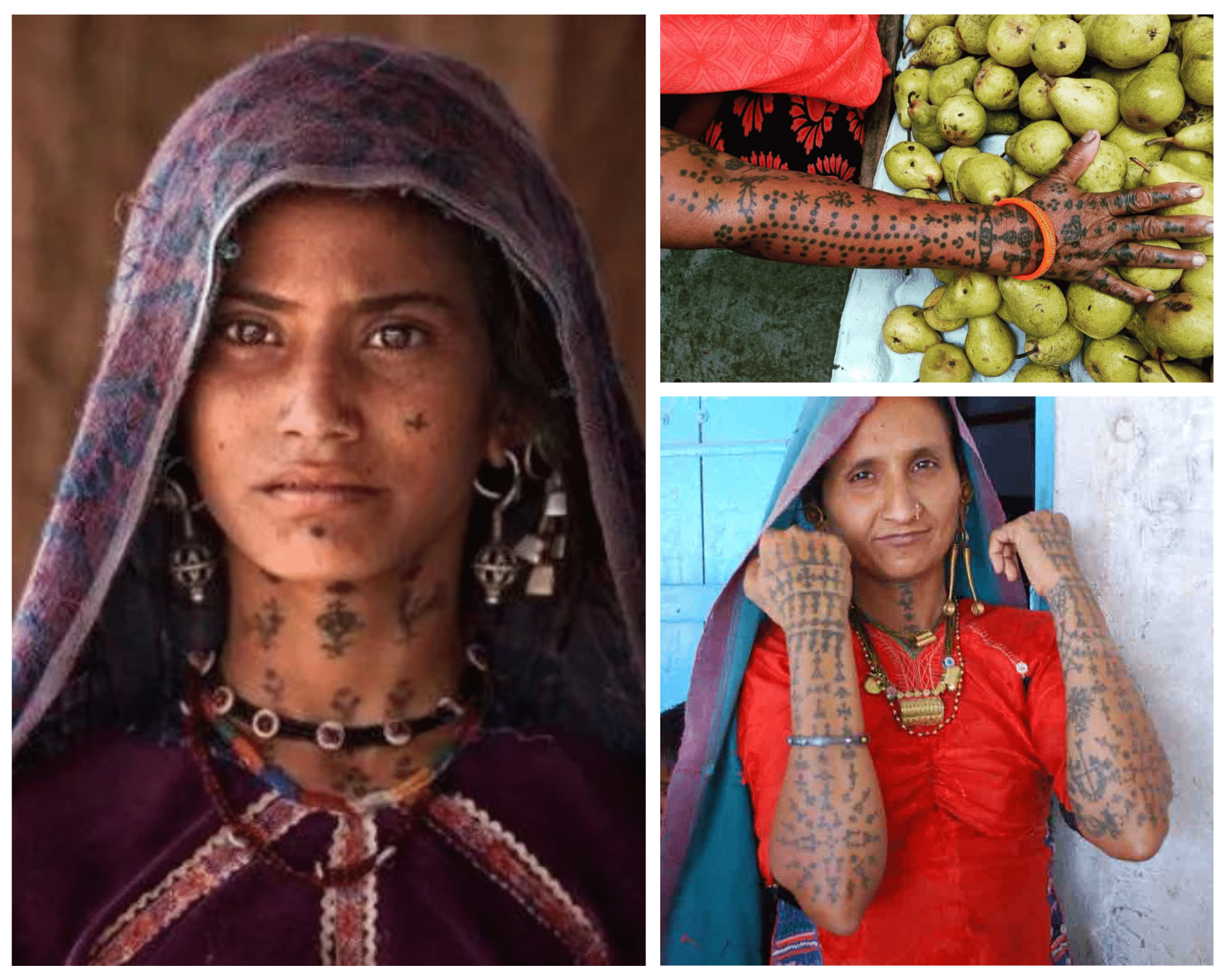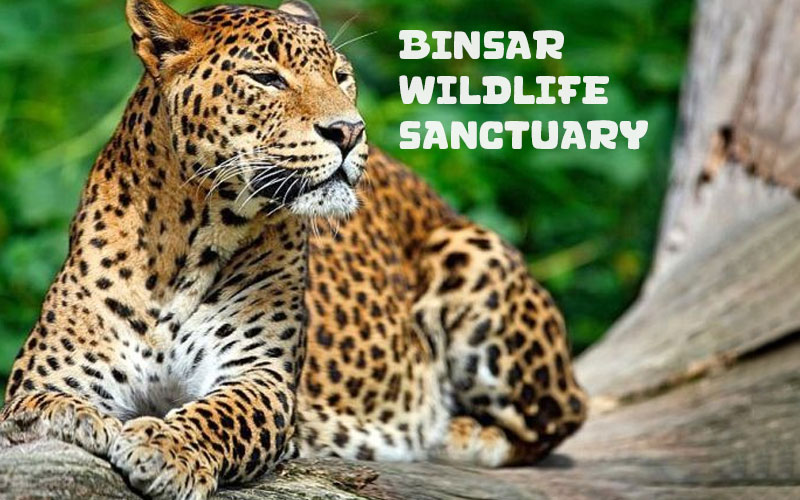Growing up, I always heard that tattoos were a Western concept, something far removed from India. But whenever I saw people around me with tattoos, I couldn’t help but think they looked so cool! By the time I was in college, getting a tattoo was like levelling up to ultimate “badass” status — people would gather around, eagerly asking for the story behind it. Teenage me was ready to join in, despite my relatives constantly reminding me that as a woman, I shouldn’t get a tattoo. It felt like a transgressive act with people exclaiming “What are you, good girl gone bad?” Casual sexism aside, the allure of tattoos remained. It was an instant conversation starter with a personal story that was always fun to uncover.
Years later, my view on tattoos began to shift. On a trip to Kerala, I took a cab from Kochi to Varkala and ended up wandering through a flea market. But what really caught my eye weren’t the clothes for sale. It was the tattoos of the Rajasthani women selling them. One elderly woman explained that her tattoo was unique to her tribe, and that’s when it struck me. As I travelled further across India, I began to notice tattoos on women. And not just on rebellious teenagers — women of all ages and backgrounds bore these designs. These weren’t trendy fashion statements or casual conversation pieces. They were cultural symbols, deeply rooted in history and passed down through generations.
That’s when I started to question everything I thought I knew about tattoos. Could it be that tattoos had always been part of our heritage? This sparked a journey to uncover India’s tribal tattoo traditions — revealing stories far more profound than I had ever imagined.
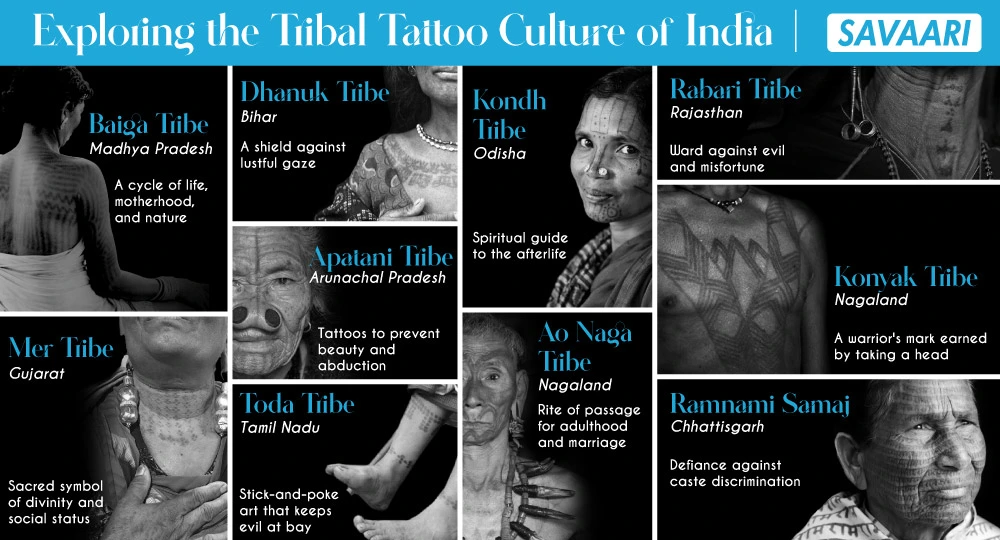
Ink that lasted millennia – Tattoos far older than you think
When we think of tattoos, it’s easy to imagine hip-hop artists, MTV music videos, bikers, or even Bollywood villains flashing their ink on screen. But tattoos have a history far deeper than the modern pop culture we associate them with today. It’s time to bust the myth that tattoos are a recent trend, when in reality, they’ve been marking human skin for thousands of years.
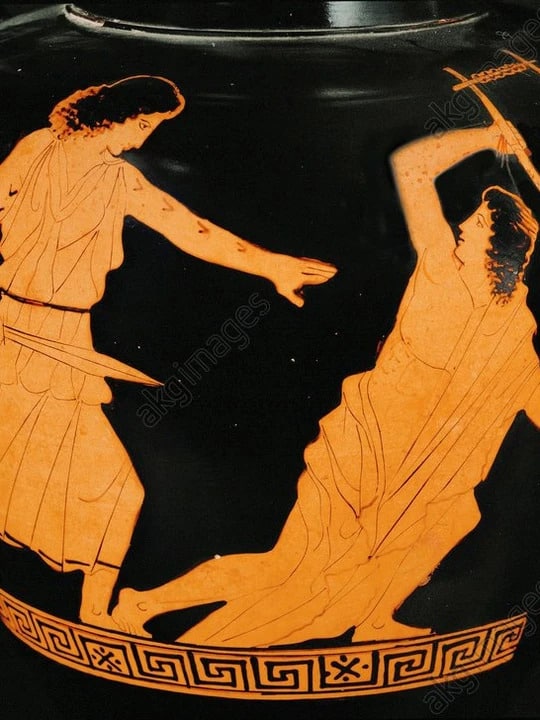
While diving into the history of tattoos, I discovered that the word “tattoo” was introduced to the English language by Captain James Cook in the 18th century. He borrowed the term from the Tahitian word “tatau.” However, the practice itself goes back long before that. Consider Ötzi the Iceman, a 5,200-year-old mummy found in the Alps — he had 61 tattoos on his body! Even mummified Egyptian women and Thracian women depicted on ancient Greek vases, dating back to the 5th century BC, were adorned with tattoos. These ancient marks were likely less about rebellion or fashion and more tied to ritualistic or medicinal purposes, showing that tattoos have been a part of human culture for millennia. Far from being about rebellion or fashion, these ancient tattoos likely had ritualistic or medicinal purposes, proving that ink has been a part of human history for millennia.
Prehistoric ink – Indian tattoos during Indus Valley Civilization
India’s tattooing tradition runs much deeper than many realize, with its roots stretching back to prehistoric times. Ancient rock paintings found in central India, dating back over 10,000 years, depict figures adorned with body art, suggesting that tattoos were an integral part of early societal practices. While direct evidence from the Indus Valley Civilization (3300–1300 BCE) is scarce, figurines and seals from that era hint at body modification practices that likely included tattoos.
If you embark on an Indus Valley road trip in Gujarat, you’ll encounter relics and inscriptions that reflect these ancient forms of body art. These early tattoos, often referred to as mehndi or henna, featured intricate designs applied to the skin using a paste made from the leaves of the henna plant. Though henna is now primarily used for temporary decoration, its deep connection to India’s tattooing history reflects the cultural significance of body art through ages.
Tattoo’s evolution from Vedic marks to medieval masterpieces
While the Vedic period in India (1500–500 BCE) doesn’t explicitly mention tattoos, there are numerous references to body markings, which may have been early forms of tattooing. These markings could have set the stage for the intricate tattoo art that flourished later in Indian history. By medieval times, tattoos, or Godna, had become widespread across rural and tribal communities, evolving into a deeply symbolic and culturally significant practice.
The legend of Shiva and the birth of Godna
One of the most widely known legends explaining the origins of Godna (tattooing) in tribal India is tied to Lord Shiva. According to the myth, Lord Shiva once hosted a grand feast for the gods. During the event, a Gond god mistakenly put his arm around Goddess Parvati, believing her to be his wife. Furious at this mistake, Parvati commanded that all tribal women should tattoo themselves to ensure they could be easily distinguished from one another. This divine decree, passed down through generations, is said to have laid the foundation for Godna as a crucial part of tribal identity, especially among the tribes of Madhya Pradesh. For these communities, Shivratri remains a significant festival, celebrating their deep connection to the divine.
Godna in the afterlife – A riddle for rebirth
In another powerful myth, Godna tattoos are believed to hold significance beyond life itself. When a spirit appears before the gods after death, it must solve a Godna riddle as part of the judgment process. Failure to solve this riddle results in the spirit being sent back to Earth for rebirth. This story, passed down through generations, emphasizes the spiritual importance of these tattoos, not only in life but also in ensuring a smooth transition to the afterlife.
Yamraj and the power of identity in tattoos
Elder women of the Gond tribe often speak of the connection between Godna and the god of death, Yamraj. They believe that when Yamraj comes to take a soul, the tattoos will help distinguish them from their husbands in the afterlife. These tattoos serve as a powerful marker of individuality, even in death, protecting the wearer’s unique identity in the spirit realm. Tattoos during this period were used as markers of identity, beauty, and social status, often doubling as talismans for protection against evil spirits.
Colonial criticism – Tattoos as acts of resistance
During British rule (1858–1947), colonial authorities labeled tattooing in India as “primitive” and “savage.” Despite these dismissive views, tattoos remained deeply embedded in tribal and rural communities. For these groups, tattoos weren’t just cultural markers; they were a way to assert identity in the face of colonial rule. The British may have seen them as backward, but for many Indians, tattoos became symbols of resistance, survival, and an unbreakable connection to their heritage.
Ink revival – Tattoos in the post-independence era
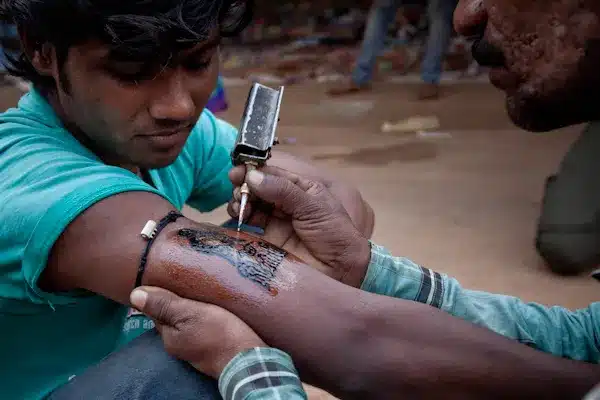
After India gained independence in 1947, tattooing continued in tribal and rural areas, though it remained relatively obscure in urban spaces. That began to change in the 1960s and 70s, when a cultural revolution took place. By the turn of the millennium, tattoos exploded in popularity in India’s cities, blending traditional tribal motifs with modern designs. Today, tattoos are more than a fashion statement — they’re a bridge between India’s ancient past and its vibrant, evolving present.
However, tribal tattoo India have remained unchanged for generations. For many, these tattoos blur the lines between fine and folk art. In the Mer/Maher and Rabari tribes of Gujarat and Rajasthan, women adorned themselves with dotted tattoos called “trajva” on their hands and necks, which served as a substitute for jewelry among those who couldn’t afford it. There are countless tribes across India, each with its own fascinating stories and rich tattooing traditions offering a deeper glimpse into the incredible diversity of India’s tribal communities.
The many faces of tribal tattoos in India – Stories of identity, tradition, and strength
During my travels, I was enamoured by the intricate tattoos worn by the people in various tribal communities. Each tattoo I encountered represented an identity, a milestone, or a symbol of protection — woven into the fabric of their lives.
As I conversed with them, I learned how these tattoos were personal reflections of their history, resilience, and strength. Each tribe had its own unique approach to tattooing, from the techniques used to the meanings behind the symbols. Here are some of the remarkable stories behind the tribal tattoos of India.
Tattoos of the Baiga Tribe – A cycle of life, motherhood, and nature
The Baiga are a forest-dwelling ethnic group primarily found in Madhya Pradesh, with smaller populations scattered across the surrounding states of central India. For the Baiga people, tattoos are deeply ingrained in a woman’s identity and beauty. The Baigas believe that tattoos are carried with them into the afterlife, as the ink fuses with the body itself, making it a permanent part of their being.
Nature-inspired motifs
As a tribe closely connected to nature, the motifs in Baiga tattoos are largely inspired by their surroundings. The Baigas consider the cow’s eye to be both beautiful and mysterious, which is why the ‘cow eye’ motif is often tattooed on the breasts and back of Baiga women. Other motifs include triangular lines representing mountains, and a sun tattoo that is positioned in the middle of the chest.
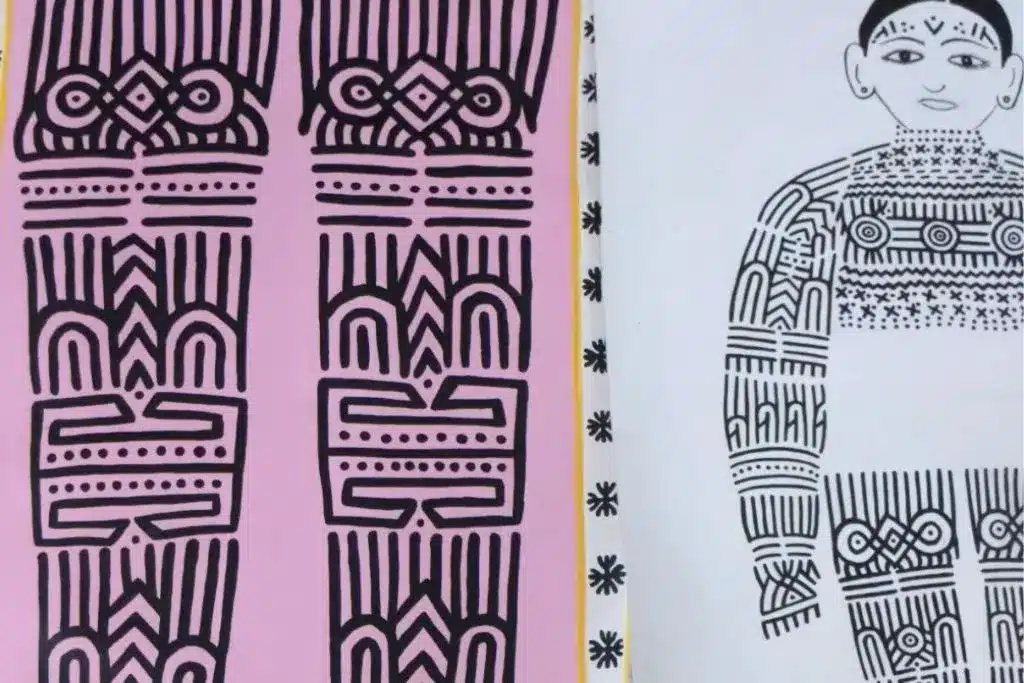
Common shapes such as dots, crosses, and circles are also used, arranged symmetrically between larger, thicker lines to create balance in the design. The forehead tattoo, often the first one a Baiga girl receives, features a symbolic moon shape at its center with geometric lines extending above the eyebrows — a distinct mark of being part of the Baiga tribe.
The tattoo journey of a Baiga woman
Baiga women begin their tattoo journey early in life. Between the ages of 8 and 10, before reaching puberty, a girl receives her first tattoo on her forehead. This tattoo serves as a symbol of her impending transition into womanhood, reminding her that she will soon take on the responsibilities of managing her home and family. It is also an indication that she is nearing the age of marriage.
“Tattoos mark every stage of a Baiga woman’s life, from childhood to motherhood.“
As the girl matures, typically between 15 and 18 years old, she gets tattooed on her back. This back tattoo is thought to enhance her attractiveness and is prominently featured by the Baiga women’s traditional attire, which is designed to highlight this intricate design. Following this, she receives tattoos on her hands, one after the other within the span of a year. These hand tattoos signify her growing participation in the community, showing that she is now ready to engage in rituals and social activities.
Upon marriage, a Baiga woman can be tattooed on her legs, a mark that signifies her full involvement in all aspects of life. After giving birth, she is finally tattooed on her chest, a design that represents motherhood and the nurturing role she plays within her family. If a woman cannot bear children, she is allowed to adopt and can still receive this meaningful chest tattoo. For the Baiga women, these tattoos complete a life cycle, each mark serving as a milestone from childhood to motherhood.
A sacred inking process
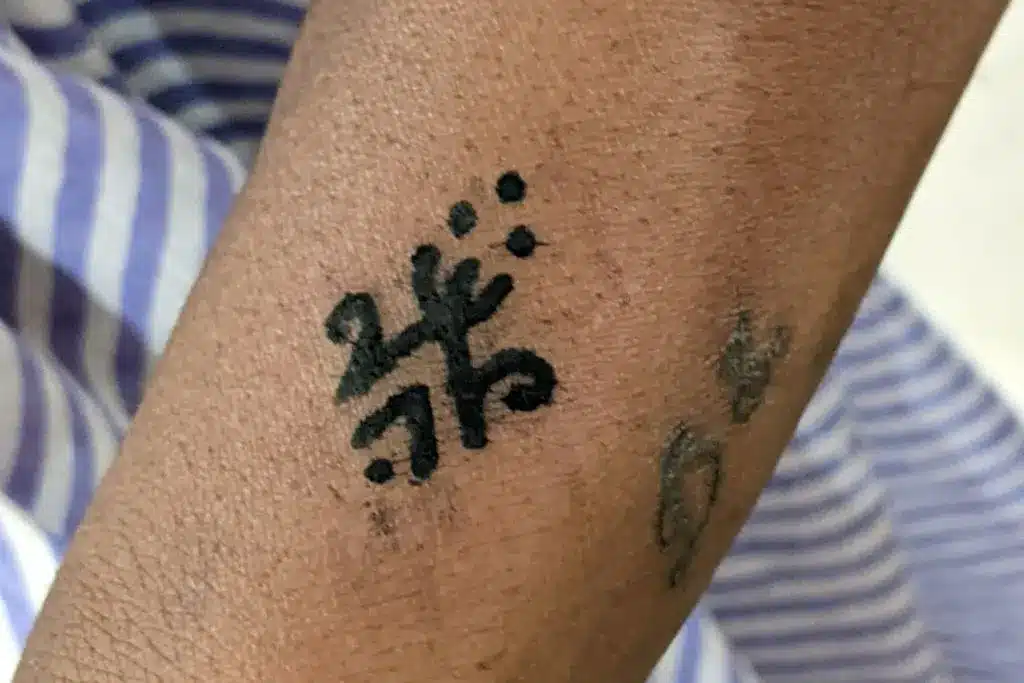
The tattooing process is considered sacred by the Baigas. One Baiga woman explained, “Our gondans are an integral part of who we are. We feel incomplete without them. It’s an art passed down from our ancestors.” The ink used for the tattoos is made from crushed Niger seeds, and the process itself takes place deep in the forest, away from the eyes of men, as it is believed that seeing a woman’s blood is a bad omen. Using a bamboo stick, the tattoo symbols are carved into the skin, and the ink is applied using a needle. After the tattooing, the area is washed with cow dung and warm water, and a local herb called Raijal is applied to help the wound heal.
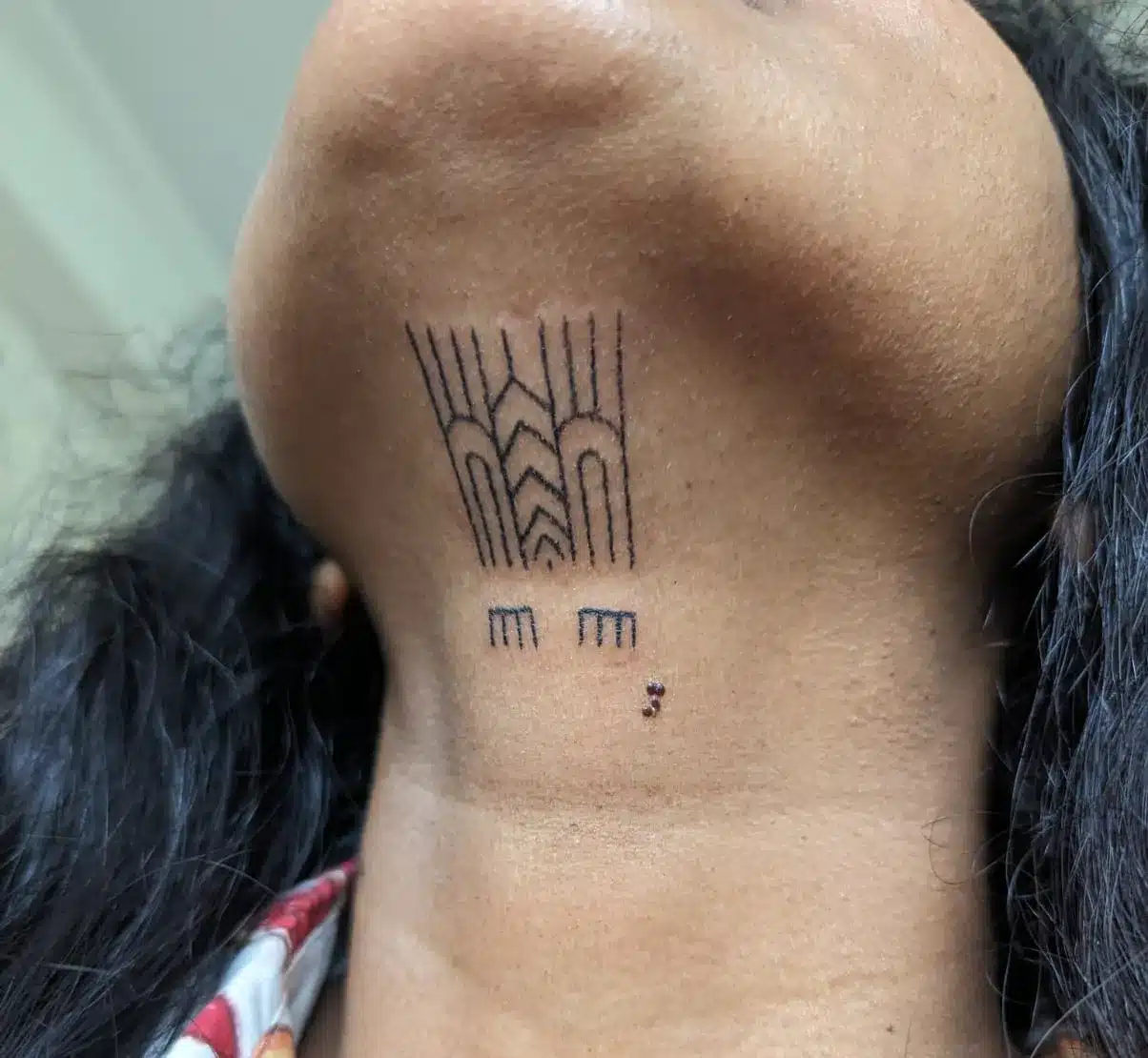
While I was learning about the Baiga tattoos, my friend Lavina, who was traveling with me from Jabalpur to Mandla, decided to get one herself. Inspired by the deep cultural significance of these tattoos, she chose a fishbone tattoo on her neck. The design featured a fishbone at the center, with flintstones on either side, symbolizing the rocks on which the fish is cooked. This tribal tattoo India represents the Baiga tribe’s close connection to their staple food, freshwater fish, blending tradition with a modern expression of appreciation for the culture.
Mer Tribe tattoos – Sacred symbols of divinity and social status
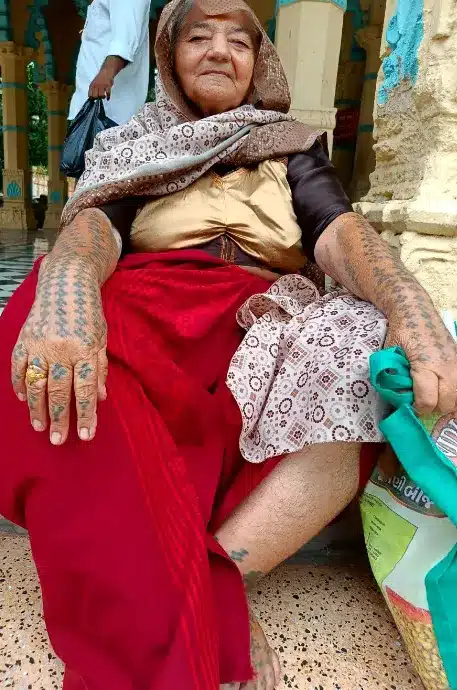
When I was in Porbandar, Gujarat, I had a fascinating conversation with an elderly woman adorned with several Jai Shree Ram tattoos. She wore a stunning golden blouse with a sari that was backless, hanging by just a thread — an effortless fashion statement!
I complimented her, and she quickly asked if I was married. When I said no, she smiled and jokingly replied, “You better get a tattoo!” Intrigued, I asked her why. “A girl without tattoos before marriage is considered to belong to a poor family,” she said, “because these tattoos symbolize status and tradition.”
She explained that for the women of the Mer tribe, tattooing starts early, usually between the ages of seven and ten. The first tattoos are inked on their hands and feet, and as they near marriageable age, tattoos are added to their necks and breasts.
“Without tattoos before marriage, a Mer girl is considered poor.”
The Mer tribe upholds a rich tattooing tradition, where both men and women cover their bodies with sacred motifs, including images of holy men, gods, and symbols inspired by nature. For Mer men, the tattooing is less elaborate but no less significant. It is customary for men to be tattooed above their wrists, on the back of their hands, and sometimes on the right shoulder. These marks serve as identifiers of their tribe and status. The ink used in Mer tattoos is made from soot mixed with cow’s urine or soot combined with the juice of tulsi leaves, symbolizing purity. The tattoos are carved into the skin using a reed stick with two or three needles inserted at the end.
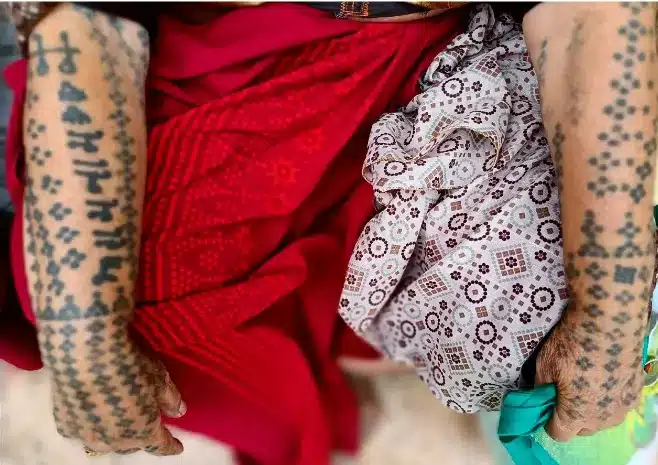
Dhanuk tribe tattoos – A shield against lustful gaze
The Dhanuk women I met in Bihar, when I was doing the Buddhist circuit trail, shared stories that were both heartbreaking and defiant. Historically, Dhanuk women were tattooed not for beautification but as a means of protection against predatory nobles. While they covered their faces with purdah (veils), their visible skin was tattooed with simple designs intended to make them less attractive to those with ill intentions.
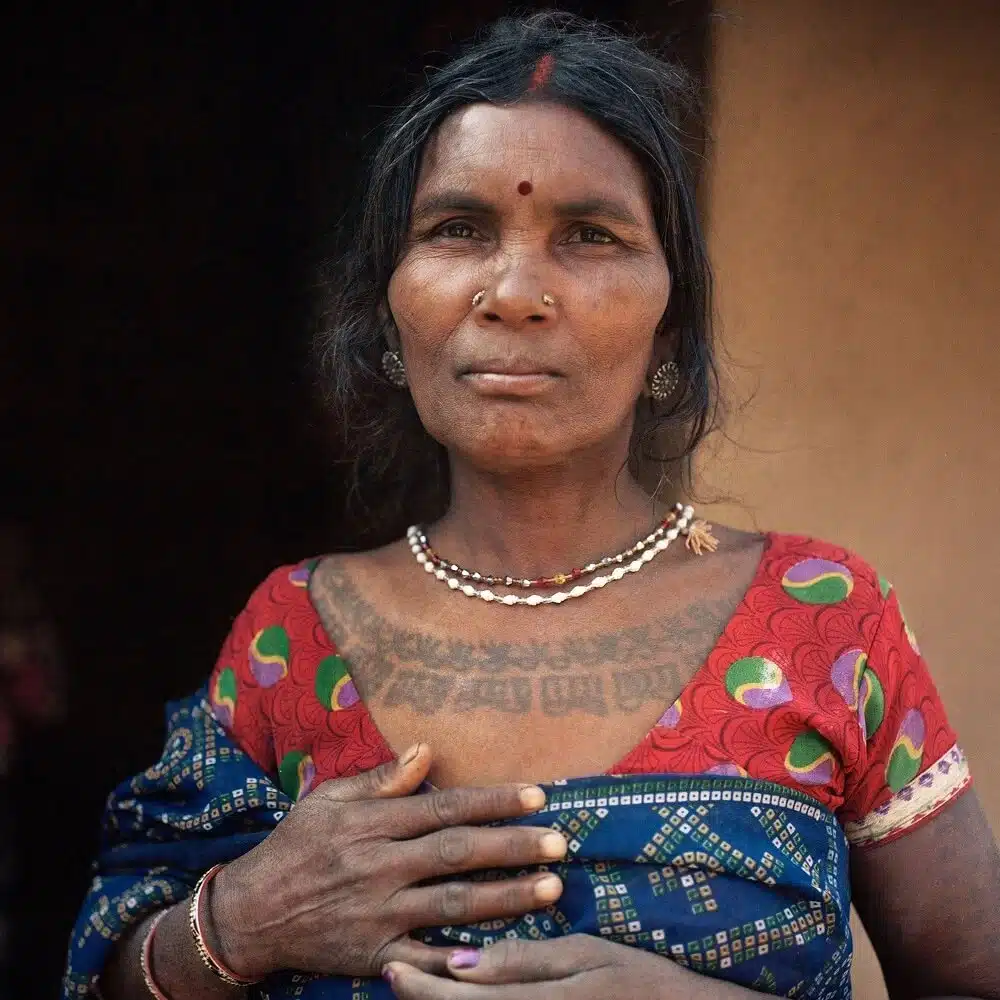
One elder Dhanuk woman I spoke with, her face and arms covered in faded tattoos, told me, “These tattoos were not our choice for beauty. They were our shield, meant to repel the eyes of those who saw us as easy prey.” It was a stark reminder of the harsh realities faced by lower-caste women, whose tattoos symbolized both their vulnerability and their strength. Yet, despite the painful reasons behind them, there was a quiet dignity in how the women bore these tattoos, a resilience that stayed with me long after I left Bihar.
Munda Tribe Tattoos – Marks of victory over the Mughals
I was on a road trip along the Grand Trunk Road, traveling from Kolkata to Amritsar, when my team and I made a pitstop in the rugged landscape of Jharkhand. It was there that I encountered several men from the Munda tribe, each proudly displaying three straight vertical lines tattooed on their foreheads. These lines were symbols of the tribe’s victories over the Mughals, acting as a permanent record of their history. As one of the elders told me, “These marks on our foreheads are our pride. They tell the story of the three times we defeated the Mughals and defended our land.”
“Three vertical lines on foreheads tell stories of the three times the Munda tribe defeated the Mughals.“
The tattooing process, as they described it, was grueling and ritualistic. Some Munda communities use sharpened bamboo sticks or thorns to pierce the skin, while the ink is made from a mixture of cow bile, soot, and natural ingredients like plants and pig fat. In some cases, the ink comes from burning grape seeds or using vegetable juice mixed with oil and soot. Depending on the size and placement of the tribal tattoo India, the process could take several days, with the pain seen as a necessary part of honoring their ancestors and preserving their history.
Kondh Tribe Tattoos – Spiritual guide to the afterlife
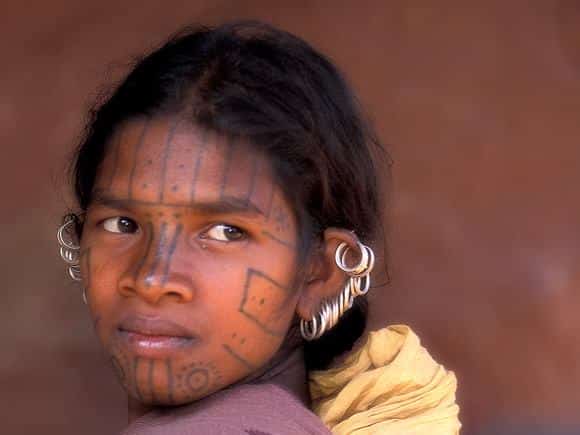
Three years ago, I traveled to Odisha for a project and spent three weeks there. During that time, I witnessed the vibrant Rath Yatra, explored stunning temples, and visited the artistic village of Raghurajpur. While there, I had the chance to meet the women of the Kondh tribe, known as “the people of the spirit world.” The Kutia Kondh women tattoo their faces and bodies in intricate geometric patterns, believing that these tattoos will help them recognize their fellow tribe members in the afterlife. Their belief in a shared connection that goes beyond the physical world fascinated me.
“Kondh Tribe tattoos serve as a map to find one another in the afterlife.”
I sat with one woman, her face adorned with beautifully intricate tattoos, as she explained, “These marks are our way of finding each other when we leave this world. Without them, we would be lost among the spirits.” The tribal tattoo India were not just personal identifiers but spiritual symbols, serving as a kind of celestial map to reunite with their ancestors and loved ones in heaven.
The designs used by the Kondh women are simple yet deeply meaningful, with each pattern symbolizing unity and the eternal bond between their tribe members. It was humbling to see how these tattoos transcended the earthly realm, guiding them in life and death, giving them peace in the knowledge that they would never be alone.
But this was just one of many unforgettable experiences in Odisha. From the tribal haats and bustling bazaars to countless cultural encounters, Odisha has a way of making you feel deeply connected and rooted in its traditions.
Ao Naga tribe tattoos – A rite of passage for marriage and adulthood
During my journey through Nagaland, I had the privilege of learning about the tattooing traditions of the Ao Naga tribe, where tattoos represent a deeply ingrained cultural rite of passage for women. In the Ao Naga community, tattoos are a ceremonial practice that women are skilled in, passed down from generation to generation. This art form, known as gondan, is an essential aspect of a girl’s journey into womanhood.
“An Ao Naga girl is considered unworthy of marriage without tattoos.”
The significance of Ao Naga Tattoos

In the Ao Naga tribe, girls are tattooed before they reach adolescence. It is a crucial marker of their readiness for adulthood, and without it, a girl may be considered unworthy of marriage, bringing shame upon her family. The ritual itself is a test of endurance, and the process is not for the faint-hearted.
One elderly Ao Naga woman, who had both her legs and arms covered in traditional tattoos, explained the gravity of the ritual to me. “The pain we endure is necessary,” she said. “It shows our strength and readiness to become women.” The tattooing is done by a skilled woman from the tribe, using a bunch of cane thorns to puncture the skin, with the root of the kamri plant. If a girl struggles or cries out during the process, a fowl is sacrificed nearby to appease any evil spirits that might be causing her pain.
The tattooing process
The tattooing itself is a ceremonial act that follows strict rules. The ink used is made from the soot of napthi tree bark, which is burnt over a fire in a pot to create the black pigment. A bunch of cane thorns is then dipped in this soot and pressed into the skin to form the desired patterns. The designs are usually geometric, simple yet bold, representing the girl’s transition into adulthood.
It’s also a rule that no men are allowed near the tattooing process. The women of the Ao Naga tribe believe that the presence of men could disturb the spiritual energy of the ceremony. I learned from one of the younger women in the tribe that the preparation for a girl’s tattooing ceremony is taken seriously, with the process being overseen by elder women who ensure that all rituals are followed to the letter.
An endurance of pain and tradition
The ritual’s intensity lies in the endurance of pain. The girls are often held down while the needles puncture their skin, and it is said that showing too much discomfort is a sign of weakness. If the pain becomes unbearable, a fowl is quickly sacrificed as an offering to mollify any spirits that may be intensifying the suffering. The girl’s ability to withstand the pain is seen as a sign to her readiness to embrace the responsibilities of adulthood and marriage.
Rabari tribe tattoos – Ward against evil and misfortune
Among the Rabari women of Gujarat, tattoos are called trajva and are deeply symbolic of both strength and protection. These tattoos are an integral part of the tribe’s identity, and the women take great pride in them, despite the pain and potential risk of infection. For the Rabari people, tattoos are seen as a safeguard, believed to ward off evil and bring protection to the wearer. The significance of trajva lies not only in the designs but also in the endurance required to receive them.
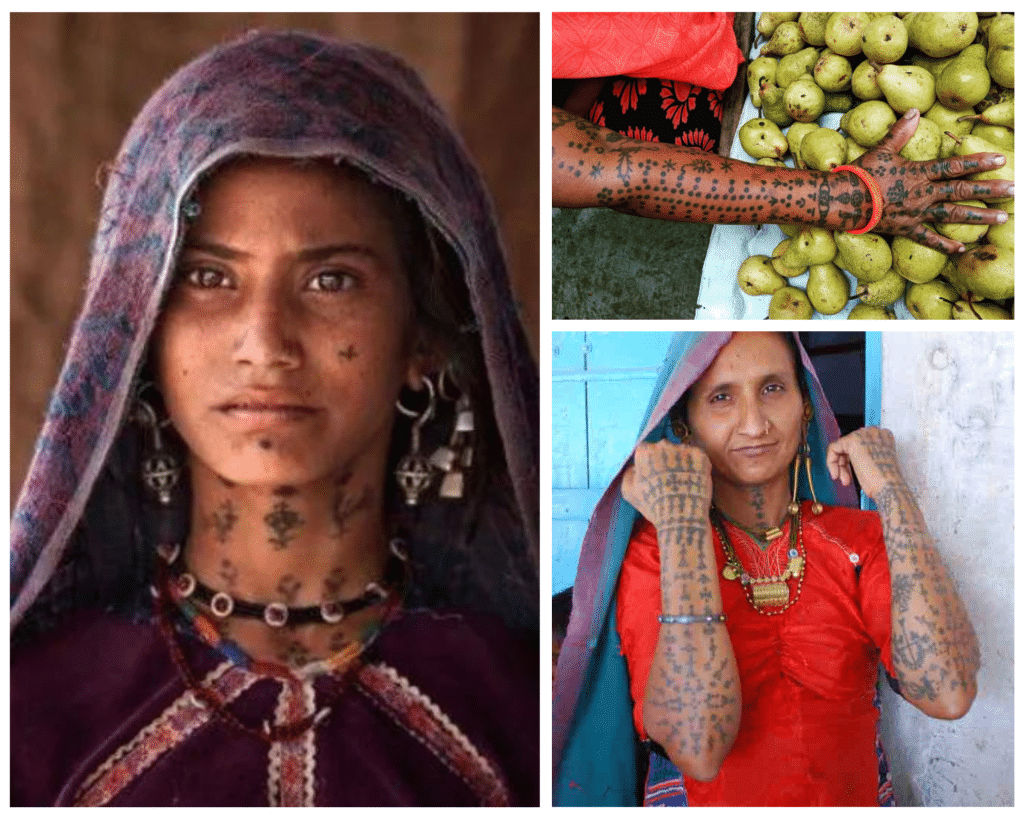
The tradition of Trajva
For Rabari women, getting tattooed is a rite of passage that marks their strength and readiness for marriage. In Rabari culture, bare skin is considered unattractive, and tattoos are used to beautify the body. I met a group of Rabari women, their skin adorned with intricate designs, who spoke of the cultural importance of these tattoos. “Trajva is who we are. Without it, we are incomplete,” one woman told me with quiet pride. Her face, forearms, and calves were covered in symbols like scorpions and snakes, all of which are believed to offer protection against harm.
“In Rabari culture, bare skin is considered unattractive.”
The designs are not just about aesthetics but also have a practical, protective purpose. Scorpions, snakes, and other symbols are inked onto various parts of the body, including the face, throat, forearms, breasts, and neck, serving as constant guardians. The men of the Rabari tribe also bear tattoos, most notably camels tattooed on the back of their right palms, reflecting their close relationship with the desert landscape and their nomadic lifestyle.
The painful process
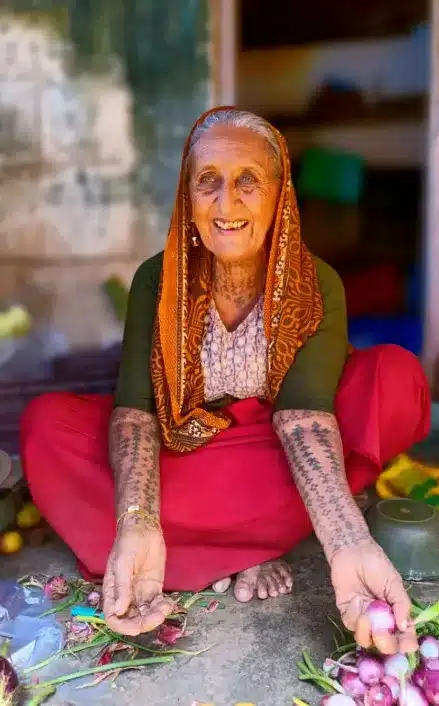
The process of getting a trajva is intense and painful. The ink used for these tattoos is prepared using a mixture of lampblack and tannin extracted from the bark of a local kino tree. In some cases, mother’s milk or even urine is added to the mixture, further highlighting the raw, natural elements of this ancient practice.
One Rabari elder described the tattooing process as both excruciating and transformative. “It hurts, but that’s why it’s special,” she said. “The pain reminds us of our strength, and the marks remind us of who we are.” The tattoos often leave the skin vulnerable to infection, but the women wear them with pride, knowing they are now part of a long lineage of Rabari women who have embraced this tradition.
Toda Tribe – The stick-and-poke art that keeps evil at bay
I visit Ooty often, but my last trip was quite different. I booked a Savaari cab from Ooty to the Toda village, located 15 kilometers away, as part of a writing project. My goal was to explore the cultural background of the Toda tribe, their deep reverence for the forests, and their extensive knowledge of forest plants and products.
For the Todas, tattoos are powerful symbols of protection, identity, and cultural expression. In Southern India, a long-lasting tribal tattoo is known as pachakutharathu, and the Toda tribe uses this ancient technique to ink their bodies with intricate designs.
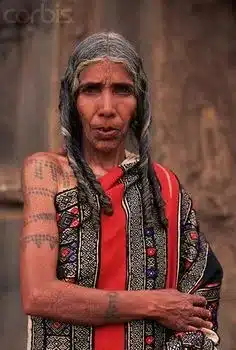
The tattooing process and motifs
The Toda tribe practices hand-poke tattooing, also known as “stick-and-poke,” where the tattoo artist uses a needle dipped in ink to manually poke individual dots into the skin. This labor-intensive method creates geometric designs that are not just beautiful but meaningful. Historically, the tattoos were done by wandering tribal tattoo India artists called Korathi, who traveled across Tamil Nadu in search of clients, bringing this ancient art form to various communities.
One of the most significant designs tattooed on the bodies of the Toda people is the kollam, a complex and graceful pattern believed to entrap evil spirits, keeping the wearer safe until they are reunited with their ancestors in the afterlife. The tribal tattoo India serve as both spiritual protection and a way to identify members of the Toda tribe from others.
The tattoo journey of Toda women
Toda women are particularly recognized for their elaborate tattoos, which cover their arms, legs, and even their faces with dark blue geometric patterns. The ink used in these tattoos is made by cutting the skin and inserting soot under it. While this process often leads to infections, it eventually leaves behind a deep blue color that becomes a permanent part of their identity.
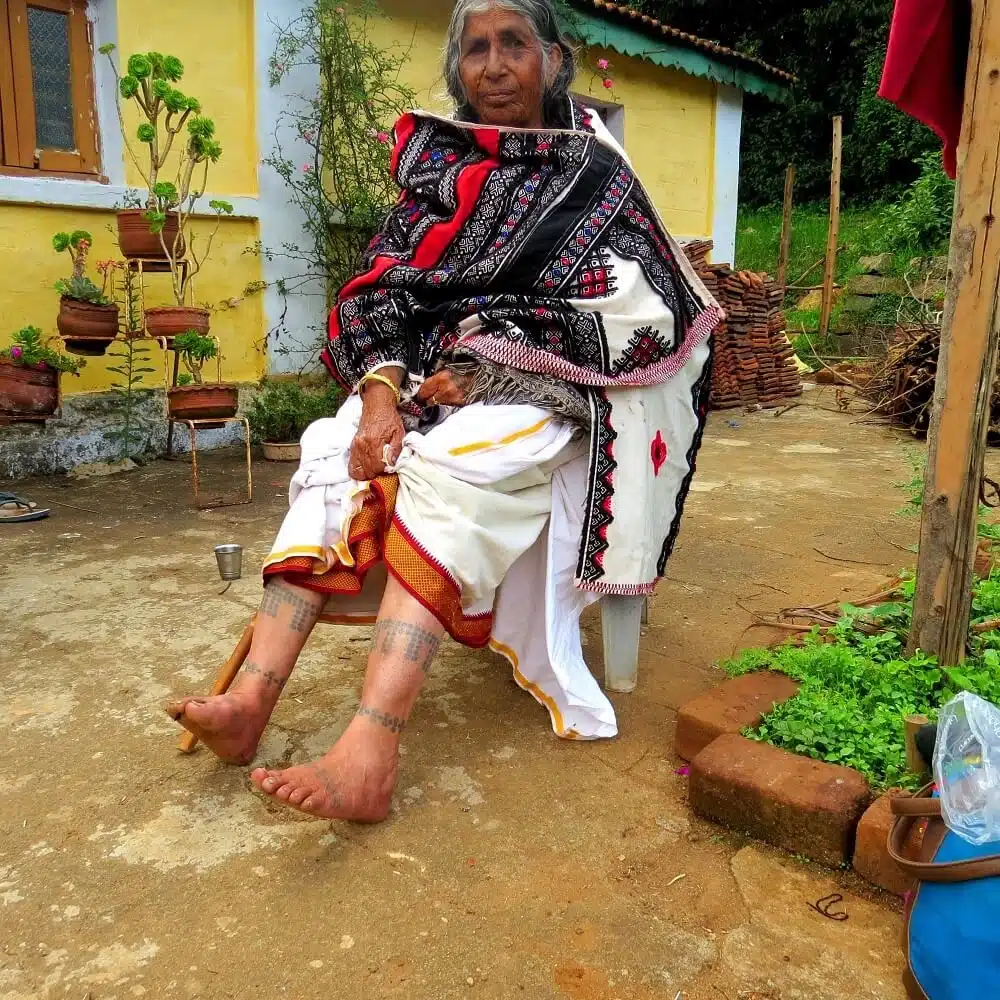
The tribal tattoo India designs are inspired by the same geometric outlines used in Toda cross-stitch embroidery, which is a hallmark of their cultural artistry. Tattoos on the hands, calves, and shins mirror the designs they stitch onto their cotton shawls. These tribal tattoo India not only serve as tribal identifiers but also as protection against evil spirits. Within the Toda tribe, these tattoos differentiate them from neighboring tribes while uniting them as a community.
Cultural significance and evolution of shawl embroidery
The tattooing tradition of the Toda tribe is closely linked to their spiritual beliefs. Even today, tribal tattoo India remain a form of tribal identification, a practice that began centuries ago to protect women from neighboring tribes. Over time, this evolved into a cultural practice that still holds deep significance.
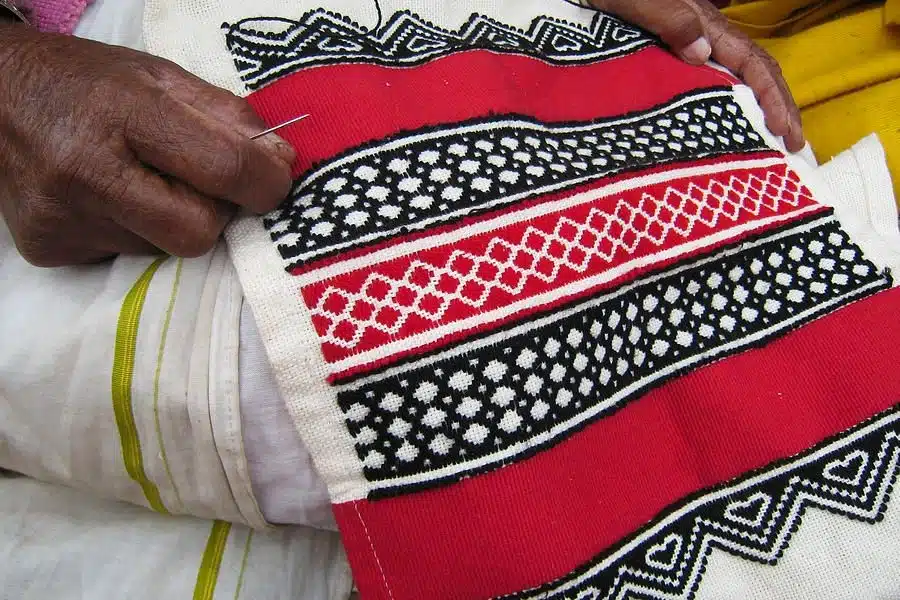
In fact, the designs that Toda women ink onto their bodies have transcended the realm of tattoos and found their way into another Toda art form — Poothukuli, or shawl embroidery. Using the same geometric patterns as their tattoos, Toda women embroider intricate designs onto white cotton shawls, using black and crimson thread. The colors hold spiritual meaning: black represents the netherworld, red symbolizes the earth, and white signifies the heavenly bodies.
The base fabric for Poothukuli shawls is always white, which the Todas trade from other weaving communities. These nine-yard shawls are adorned with patterns that not only tell the story of the tribe’s spiritual ideology but also preserve the tribal tattoo India motifs that are central to their cultural identity.
Apatani Tribe Tattoos – Tattoos to prevent beauty and abduction
In the serene Ziro Valley of Arunachal Pradesh, the women of Apatani tribe is known for its distinctive tattooing tradition and noseplugs, which is deeply intertwined with their identity. The tattoos, which stretch from the forehead down to the tip of the nose and from the lower lip to the chin, are a significant marker of tribal identity for the women of the Apatani tribe. This practice, passed down through generations, begins when girls reach the age of ten and is performed during the winter months to minimize pain and quicken the healing process.
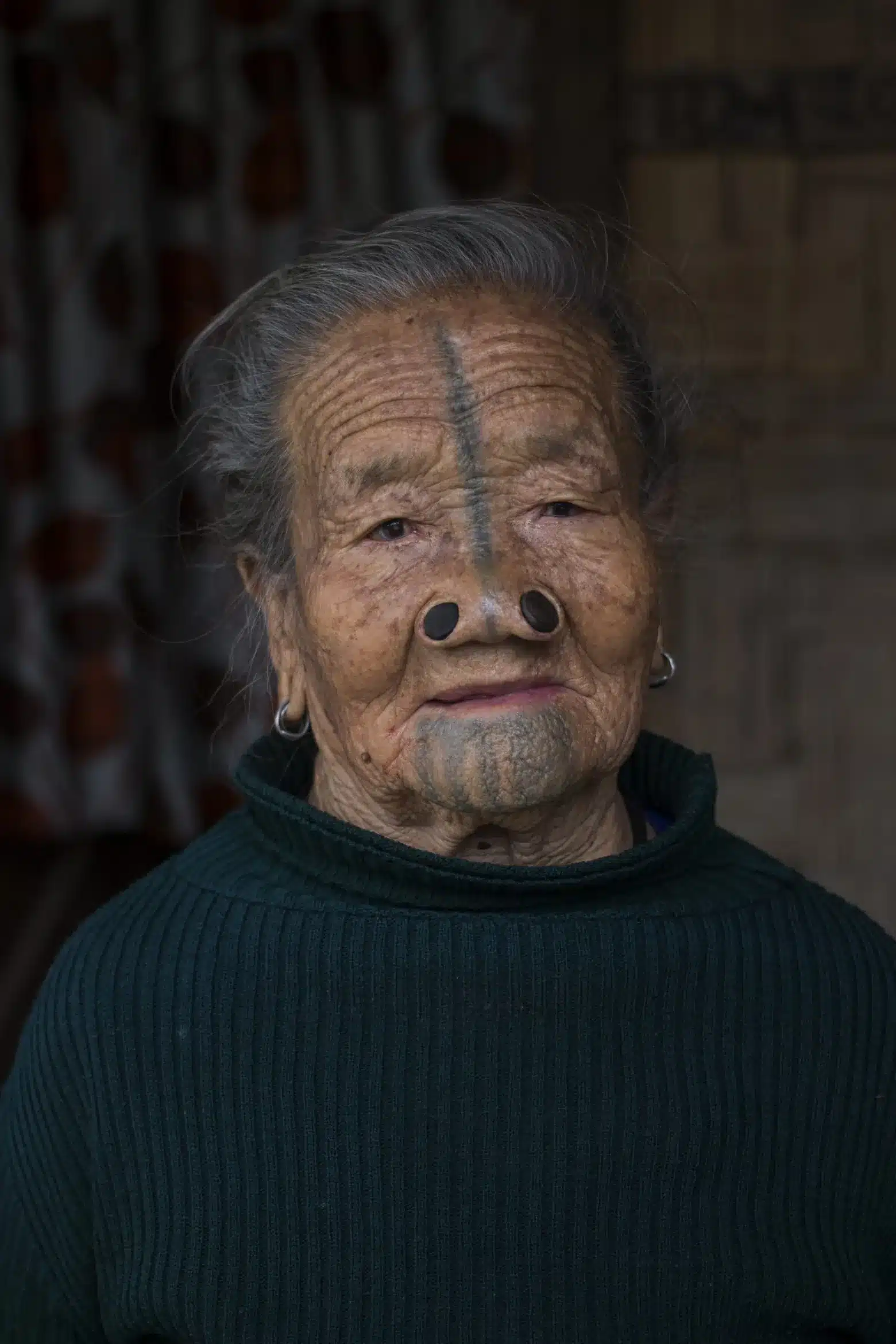
Tattoos as a defense against abduction
The origins of these peculiar beauty standards trace back to a time when Apatani women were renowned across the valleys for their unparalleled beauty. This allure, however, became a double-edged sword, as it led to men from neighboring tribes kidnapping Apatani women. In a bid to protect their women from such fates, the Apatani men conceived the idea of altering their women’s appearances to make them less appealing to outsiders. Thus, the practice of facial tattooing and the insertion of nose plugs began, with elder women tattooing young girls as soon as they reached ten years of age. These modifications, while initially intended to deter, evolved into symbols of identity and pride for the Apatani women.
“The tribe of Arunachal where womenfolk want to look ugly.”
The process of tattooing in the Apatani tribe is as intricate as it is painful. The ink used is created from soot, known as chinyu, collected from the bottoms of heavily used utensils and mixed with animal fat. The tattooing needle, called Iimotre, consists of a bunch of three-headed thorns tied together, and the ink is hammered into the skin with a small hammer known as Empiia Yakho. To ensure that the tattoos become more prominent, the skin is deliberately left to get infected, allowing the tattoos to grow larger and clearer over time.
Konyak Tribe Tattoos – A warrior’s mark earned by taking a head
I visited Nagaland to attend the Hornbill Festival, an event that brings together all seventeen Naga tribes to celebrate and promote intercultural harmony. It was during this festival that I encountered the Konyak tribe, one of the largest Naga ethnic groups, who inhabit the Mon District, also known as The Land of the Anghs. The tribe’s traditional chiefs, known as Anghs, hold immense power and respect within the community. The Konyaks’ tattoos, especially the striking facial tattoos worn by men, are a testament to their headhunting legacy.
“A Konyak man wasn’t truly a man until he took the head of an enemy.”
Among the Konyaks, boys were not considered men until they had taken the head of an enemy from a rival village. Only then could they earn their facial tattoos, marking their transition from boyhood to manhood. This gruesome initiation involved a group of young men banding together to bring back the head of a foe. The tattoos were always applied by the chief’s wife, a woman of noble blood, who pricked the skin on the face, and if the young man could withstand the pain, she would extend the tribal tattoo India to his neck and chest.
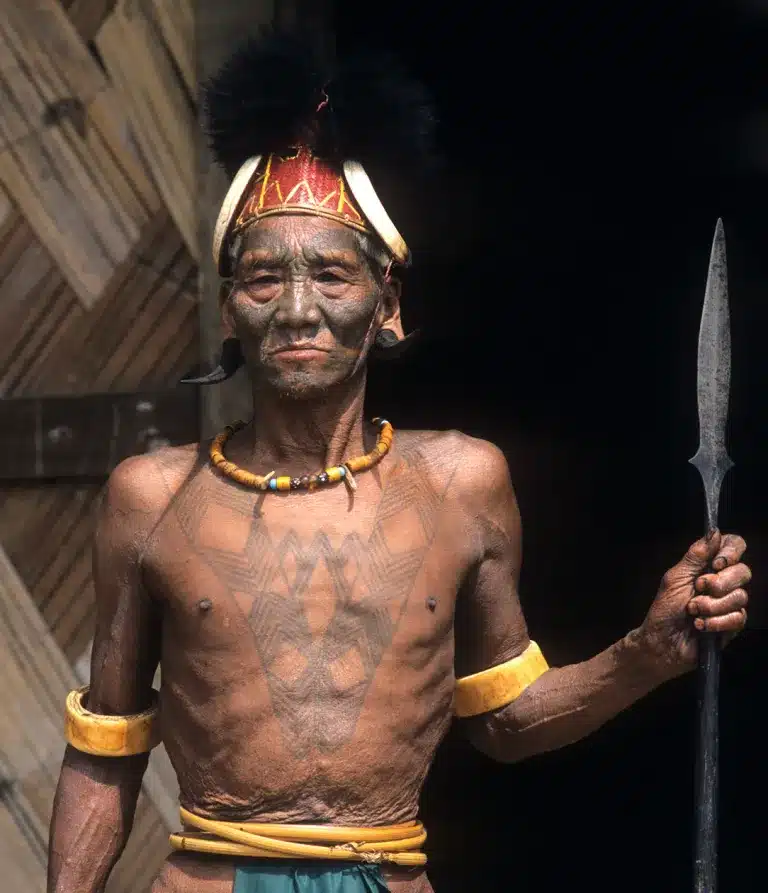
One Konyak man shared with me the pride that came with this initiation. “The proudest moment for any headhunter was the day they got their first head. I remember walking into the village with my chest full of pride after my first kill, dancing as I carried the head to our Angh. That’s the day I became a man.” He spoke of how the head was seen as a valuable possession, believed to bring luck and prosperity to the village, ensuring abundant crops and warding off evil spirits.
Skulls as trophies – Displays of power
Headhunters would hang the skulls of their enemies at the entrance of their homes, as a display of their strength and status within the tribe. This Konyak man’s eyes lit up as he recounted the excitement of his reward ceremony, where the villagers gathered to feast on pig meat and rice beer in celebration of his achievement.
Though headhunting has long been banned since British rule, the Konyaks remain proud of their past. Today, festivals like Aoling and the Hornbill Festival keep their traditions alive, allowing the Konyak people to showcase their rich culture, even as they adapt to modern life.
Santhal Tribe Tattoos – Marking life, strength, and tradition in tribal tattoo India
The Santhal tribe, native to Bengal and Jharkhand, carries a profound tradition of tribal tattoo India, where distinct tattoos represent different stages of life for men and women. These tattoos are not just about body art; they hold significant cultural meaning and are deeply rooted in the Santhal community’s beliefs and practices.
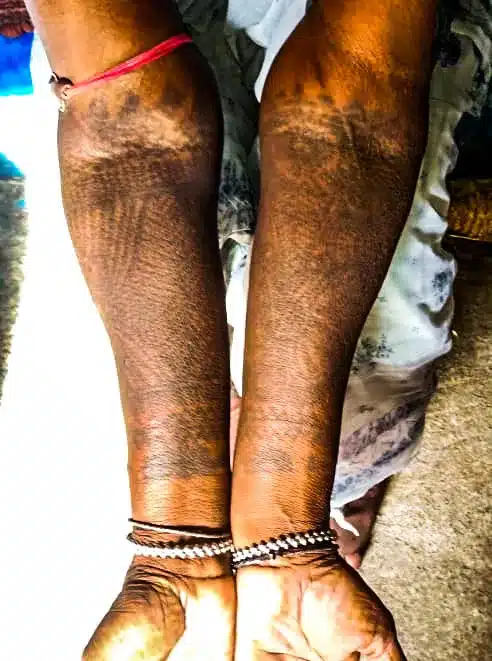
The story behind the tattoos – Richness in the afterlife
If you ask any Santhal grandmother about her tattoo, she will likely share the following tale:
“In heaven, when a girl goes to fetch water, a frog watchman guards the well. The frog asks the girl, ‘What did you bring for me from the earth?’ The girl then offers a piece of her tattoo. Only then does the frog allow her to fetch water. The more tattoos a girl has, the richer she is in heaven.”
This story reflects the Santhal belief that tattoos are not just markers of identity on earth but a symbol of wealth and status in the afterlife.
Tattoos for men – The sikka and the power of odd numbers
For Santhal men, tattoos take a unique form. Instead of traditional ink, men bear the “sikka,” a coin-shaped burn mark on their left forearm. According to Santhal tradition, men are not allowed to ink their bodies, so they use this method to mark themselves for the afterlife, just like women with their tattoos.
The number of sikka must always be odd, typically up to seven, as odd numbers symbolize life in the Santhal belief system, while even numbers represent death. The process of creating a sikka involves a roll of cotton cloth, similar to a cigar, which is set on fire and placed on the forearm. The burning cloth slowly burns the skin, leaving a mark. The wound is then covered with burnt cotton ash to aid healing. A blister forms, and after it heals, a permanent round mark remains.
Tattoos for women – Flower patterns and the journey to motherhood
Santhal women are adorned with intricate flower-patterned tattoos on various parts of their bodies, including the face. These tattoos mark significant stages in a woman’s life, particularly as she prepares for motherhood. The process of tattooing is painful, but it is seen as a rite of passage—an experience that strengthens and prepares young women for the challenges ahead.
Ramnami Samaj Tattoos – Defiance against caste discrimination
In the late 19th century, the Ramnami Samaj, a religious movement in central and northern Chhattisgarh, used tattoos as an act of defiance against the rigid caste system that denied them basic rights. The Ramnamis, followers of Lord Ram, were forbidden from entering temples and forced to use separate wells because they were considered “untouchables.” In response, they tattooed the name of Lord Ram all over their bodies as a profound statement of devotion and rebellion.
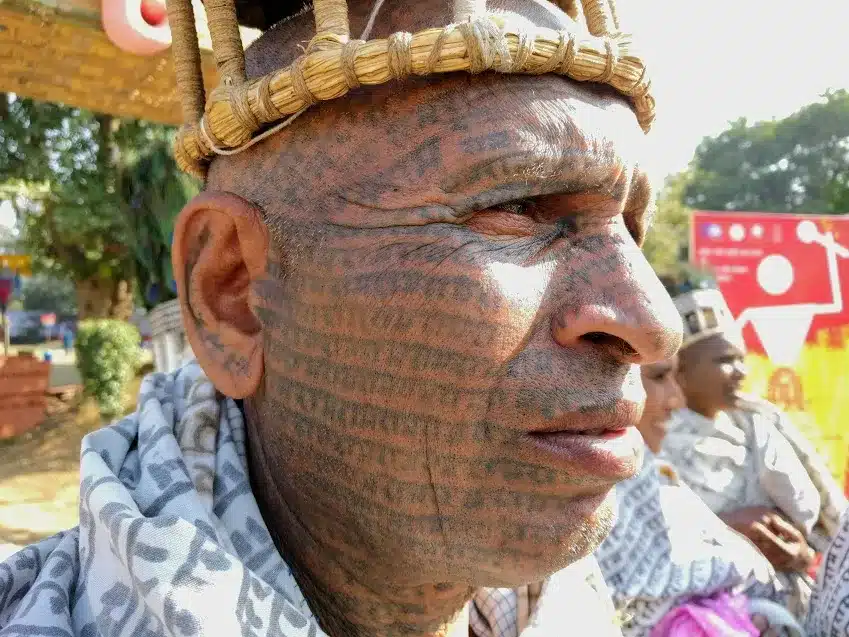
More than a hundred years later, this practice remains central to the Ramnami identity. Every child born into the community is tattooed by the age of two, usually on their chest, to mark them as a follower of Ram. Full-body tattoos, once a common practice, are now less prevalent as younger Ramnamis seek education and work outside their villages. However, the legacy of these tattoos still holds strong.
In speaking with members of the Ramnami Samaj, I learned that these tattoos are not just acts of religious devotion but symbols of resilience in the face of centuries of discrimination. Despite the changing times, the Ramnami Samaj continues to preserve its unique tradition, proudly wearing their ink as a badge of both faith and resistance.
Bhil Tribe Tattoos – Cultural markers and access to the afterlife
The Bhil tribe, one of the largest indigenous groups in India, has a long history of tattooing that is deeply rooted in both aesthetic and spiritual significance. Bhil women, in particular, embrace tattoos as a form of protection from evil eyes and as a way to enhance their beauty. The Bhils inhabit the districts of Dhar, Jhabua, Khargone, and Ratlam in Madhya Pradesh, and their presence extends to neighboring states like Maharashtra, Gujarat, and Rajasthan.
Tattoos of the Bhil women
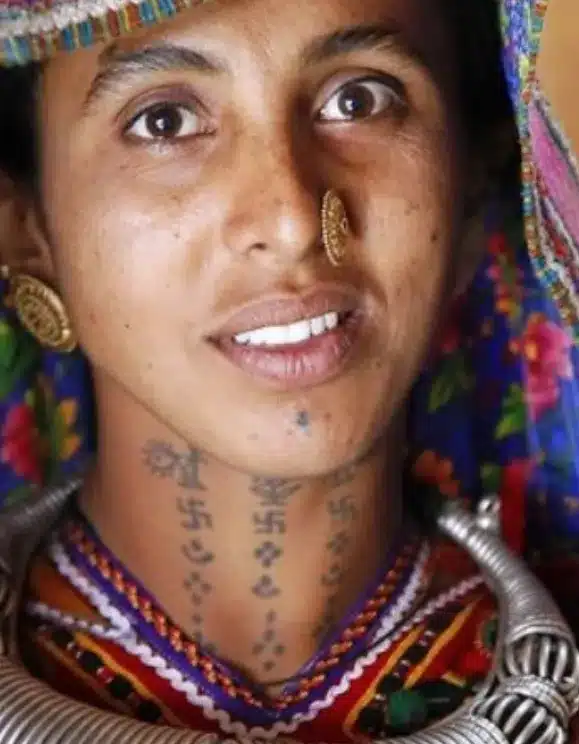
Bhil women are easily recognizable by their distinctive tattoos, most notably the bird-like designs etched near the side angle of both eyes. These tattoos, which give the women a permanent long-lashed appearance, are a striking symbol of their identity. Birds and scorpions are the most common motifs among the Bhils, with many women proudly wearing these designs on various parts of their bodies. These tattoos serve not only as protection against evil but also as a symbol of beauty and attractiveness within the community.
In addition to facial tattoos, Bhil women are known for their love of thick, bold tattoos that cover visible parts of their bodies. The tattoos often serve as a cultural marker, indicating the tribe or community to which a woman belongs. The women of the Bhil tribe are particularly fond of their traditional tattoo indian marks, and the tribal tattoo India designs they bear help distinguish them from members of other communities or tribal groups.
One Bhil woman explained to me, “These tattoos are more than just marks. They tell the story of who we are. They protect us, they beautify us, and they stay with us forever — even when everything else is gone.”
Tattooing as a spiritual marker
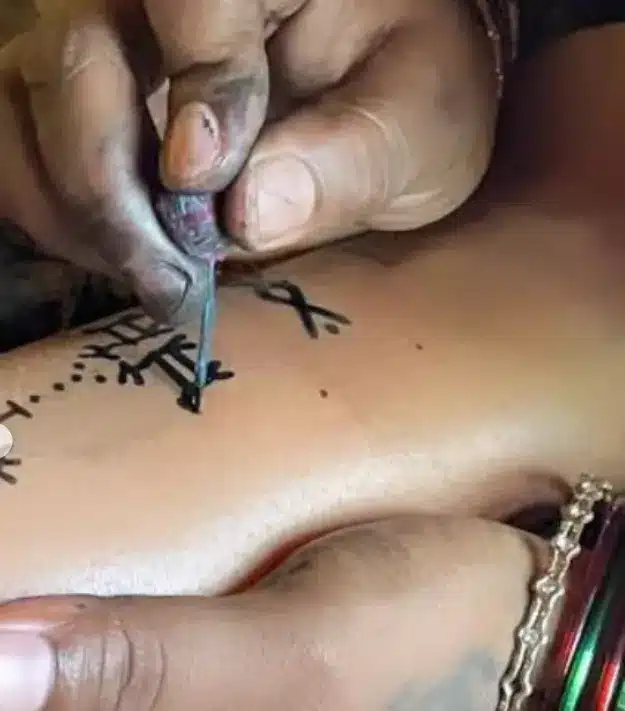
The Bhils believe that the tattoos they carry with them are not just for this life but extend into the afterlife. The marks are thought to serve as evidence of their good deeds and are symbols they will carry with them into the next world. This belief in the spiritual significance of tattoos gives Bhil women a strong sense of identity and security. The process of tattooing, with its enduring designs, reinforces their connection to their group and its traditions.
In the Bundelkhand region, there is a saying among rural people that while all other ornaments are taken off a woman when she dies, her tattoos are the only fortune she carries to the next world. This sentiment highlights the deep emotional and cultural attachment to tattooing, which is seen as a lasting part of a woman’s identity.
Tribal tattoo India techniques
The process of tattooing among the Bhils is intense and often involves using vegetable dye injected into the skin through continuous pricking with a needle. This method, while painful, produces vivid and long-lasting designs. The tattoos themselves are symbols of pride, and the Bhil women embrace the pain as part of their cultural heritage. In Chhattisgarh, women are particularly fond of tattooing, and their marks are highly valued, not just for their beauty but for the sense of belonging they provide.
How tribal women in India wore their identity and power
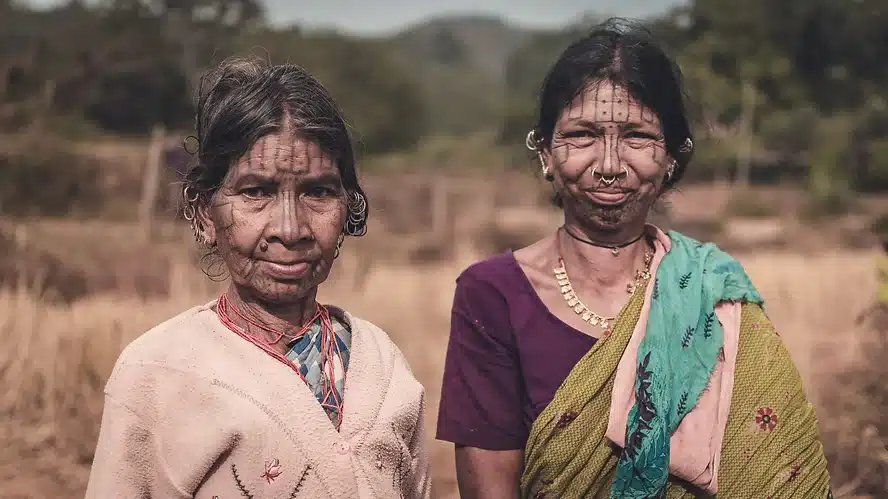
Tattoos on women today often come with a fair share of misconceptions, particularly tied to sexism. Yet, tattoos have long symbolized empowerment, especially in today’s world, where conversations about bodily autonomy, gender rights, and feminist movements take center stage. However, for generations, tribal women in India have worn tattoos not as acts of rebellion but as reflections of their cultural identity, resilience, and inner strength.
At a time when women’s rights were severely limited — both politically and socially — these markings were far more than just ornamental. Tattoos symbolized personal power, a tangible sign of endurance and the wearer’s connection to her community. These tattoos of tribals often denoted trust, as they signified caste, gender, ethnicity, and social standing. Each tribe had its unique methods, pigments, and designs, each deeply rooted in their cultural practices.
Tattoos as tools of protection and cultural heritage
That said, these tattoos weren’t always born of empowerment alone. In some cases, they carried a darker history of oppression, acting as protection against men, who might abduct women or subject them to their rapacious gaze. As I spoke to many tribal women during my travels, it became clear that these tattoos had evolved into their most cherished form of jewelry — permanent symbols that could not be taken away, even in times of hardship. One Bhil woman I met shared, “These tattoos are the stories of our lives, our protection, our pride. No one can steal them from us.”
In remote areas, where the threat of abduction by rival tribes was very real, tattoos served dual purposes: protection and identity. Each tribal tattoo India carried profound significance, symbolizing the strength required to endure the pain of the process, as well as the cultural heritage it represented. In many cases, these marks were seen as talismans, protecting the women from harm, and signifying their place within their tribe.
A passport for protection and the afterlife
One of the most fascinating aspects of these traditions was that tattoos were traditionally a female pursuit but not just limited to them. It was not just the women in the family who would bear the tattoos but also the ones who would apply them in stick-and-poke style (where one or multiple long needles are tied together to manually create a tattoo). Ttribal tattoo India were not just meant for protection in day-to-day life but they were also a passport for forgiveness of sins and admission to heaven. Such was their importance that in some regions of Mysore, it was believed that Hindu women who were not tattooed with certain designs were considered unclean.
Tribal vs. Modern Tattoos – Rooted in tradition, driven by imagination
Tattoos have long been an integral part of Indigenous and tribal communities worldwide. After meeting these various tribal communities, I’ve seen how they adorn their bodies with tattoos inspired by nature, their history, and their spiritual beliefs. What struck me most was how different tribal tattoos are from the modern tattoos you see today. For tribal people, their motifs are based entirely on belief systems, each one rooted in a sense of heritage and tradition. I’ve heard elders tell younger generations to carry on these exact designs — they believe in them wholeheartedly, and for centuries, the same patterns and motifs have been tattooed onto the skin, unchanging and unwavering.
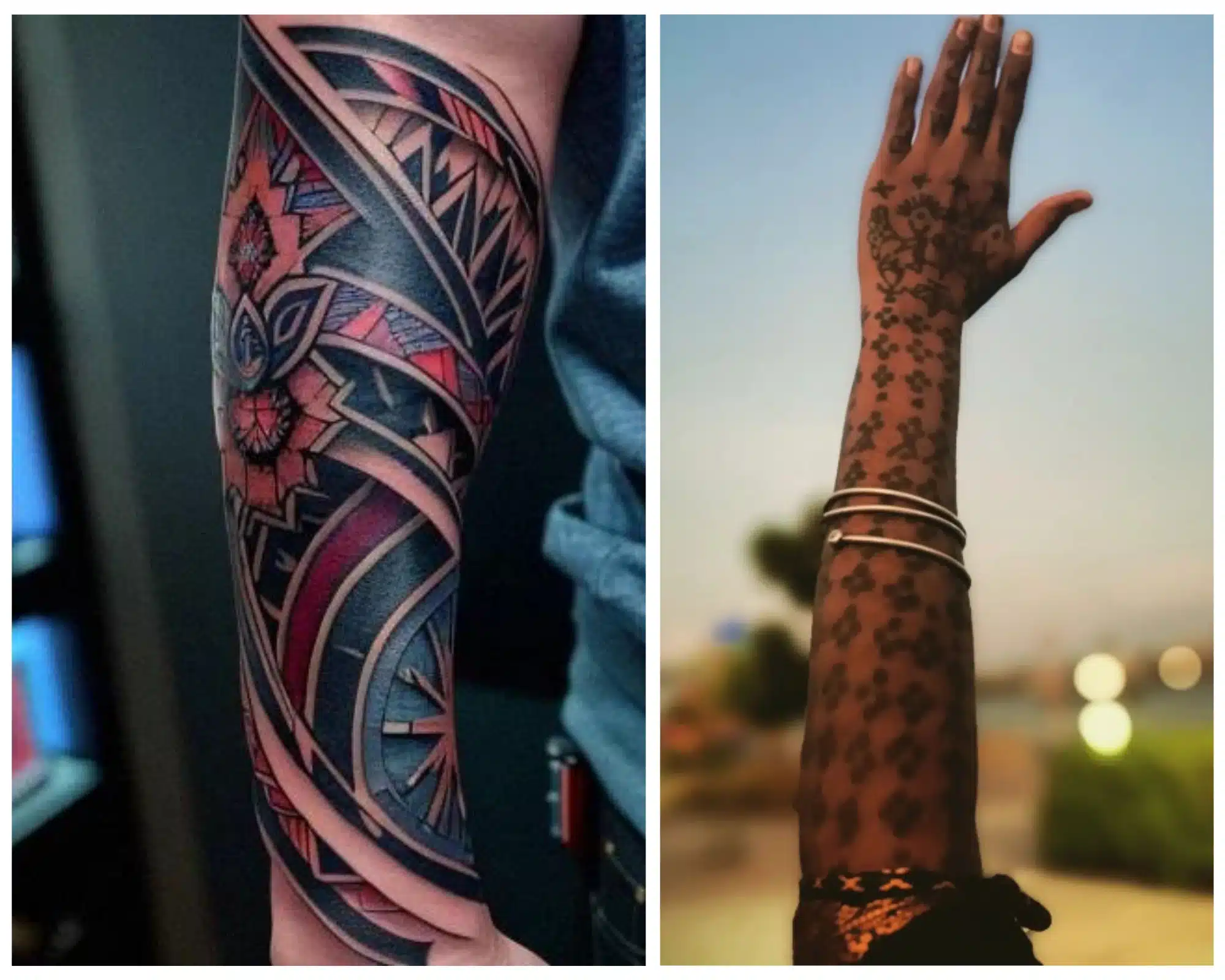
In contrast, modern tattoos are more about personal expression, driven by imagination. The tattoo design India changes with trends, from one person to the next, and are rarely tied to any long-standing traditions. While modern tattoos often reflect individuality, tribal tattoo India reflect a collective history, a shared cultural identity that has stood the test of time. Both are beautiful in their own ways, but the enduring symbolism behind tribal tattoo India feels deeply personal and powerful, a connection to the past that modern tattoos simply don’t carry.
The type of tools people use for tattooing has also evolved. While some cultures still use traditional tattoo indian tools, in large part, the tools that tattoo artists use today are much safer than those of previous years. Modern tattoo artists must have certain licenses and precautions to keep their human canvases safe and healthy.
Art in skin – What to notice on your next trip
When you’re traveling, it’s natural to get lost in the beauty of India’s landscapes. But what I’ve realized is that the true beauty also lies in the people you meet along the way. This became clear to me during my own travels. While I loved visiting stunning places, it was the conversations with the local tribal communities that opened up a whole new world of heritage and culture for me. Their body art—tribal tattoo India rich with history and meaning—gave me a deeper understanding of what art truly is. It’s everywhere.
So, the next time you travel, don’t just explore the scenery. Take a moment to appreciate the people and the stories they carry. As I did, book your trip by downloading the Savaari car rental app, immerse yourself in the incredible art and culture that’s all around you, and get a tattoo! Sometimes, all it takes is a closer look to find inspiration.
Last Updated on October 10, 2024 by Shabari Shankar
